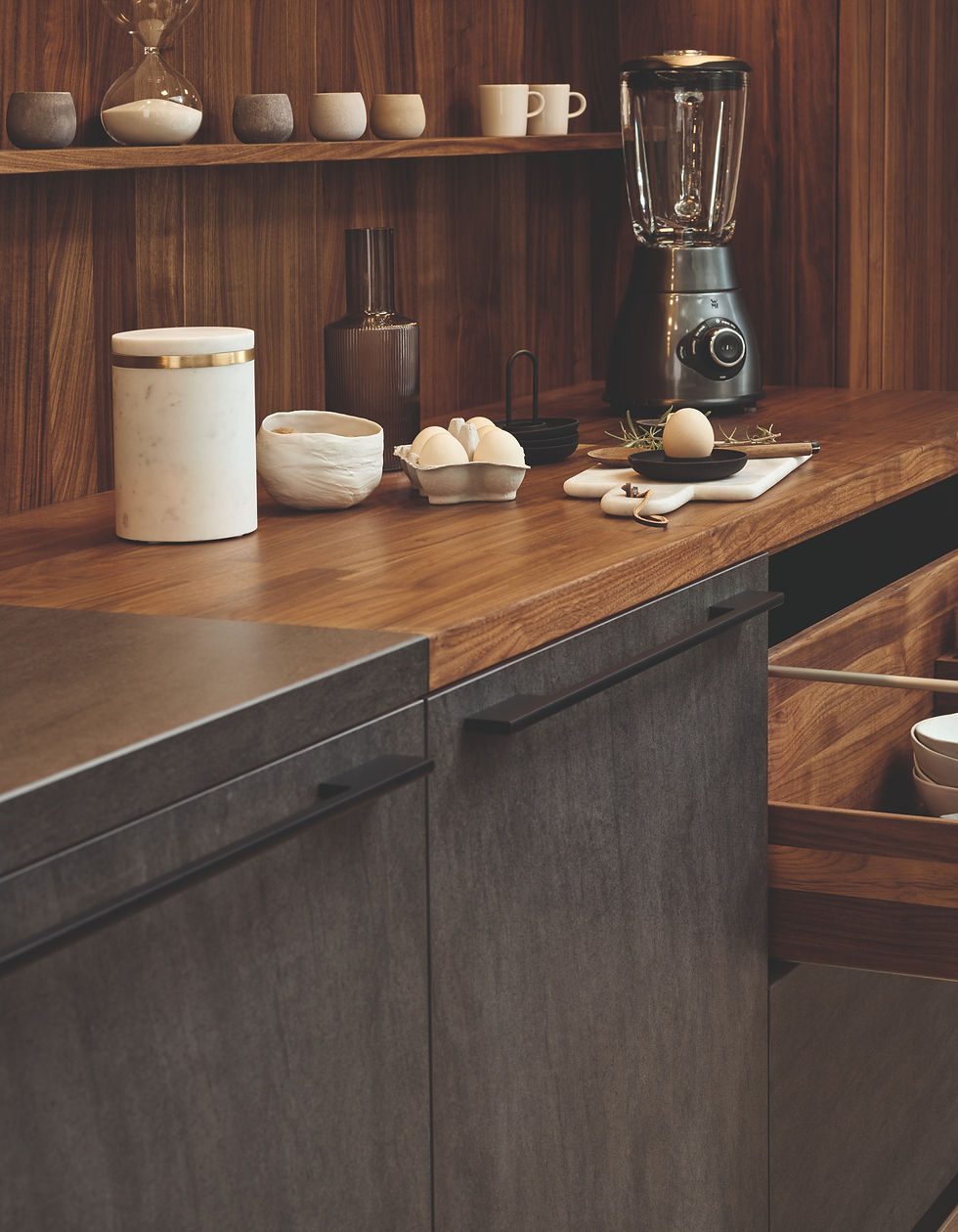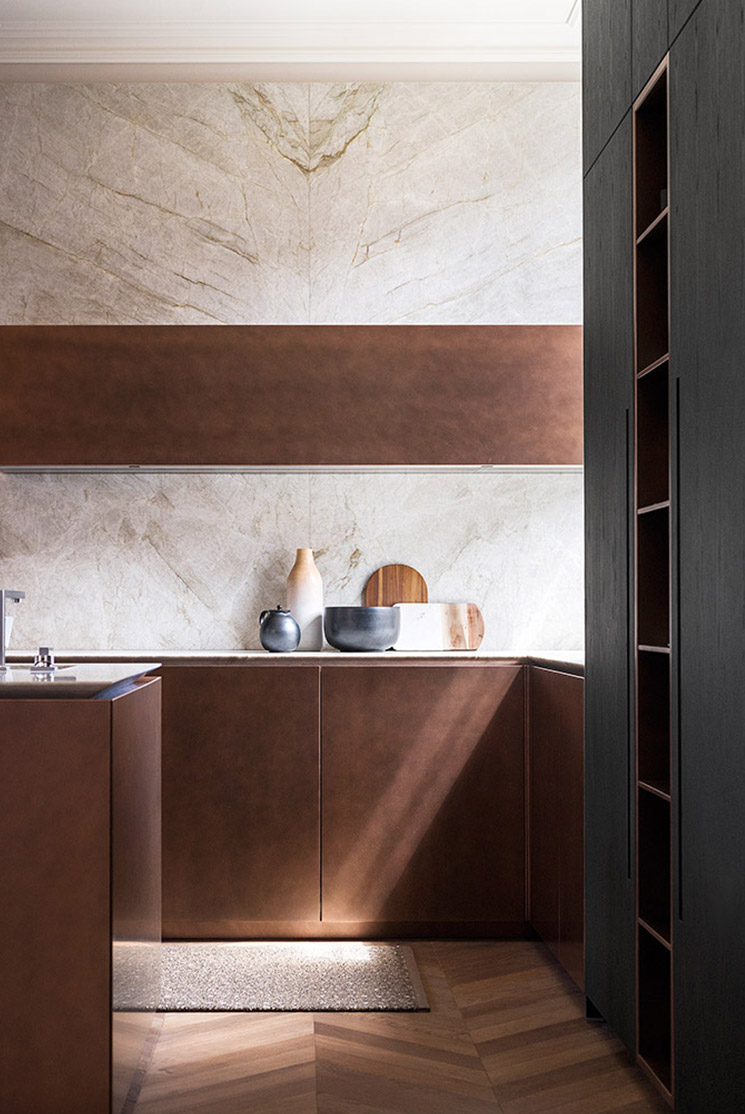Elevate Your Kitchen with Modern and High-End Custom Options
When designing a modern and sophisticated kitchen, the choice of cabinetry plays a pivotal role in setting the tone and enhancing the overall aesthetic. European kitchen cabinets have gained immense popularity in recent years for their sleek design, functional features, and high-quality craftsmanship. In this blog post, we'll delve into the diverse material choices available for European cabinetry, ranging from classic favorites to cutting-edge innovations. Whether you're renovating your kitchen or building a new one, selecting the right material for your custom kitchen cabinets will undoubtedly elevate your culinary space to a new level of luxury and style.
Wood: Nature's Timeless Offering

Traditionalists and aficionados of classic design often gravitate towards solid wood for their European cabinetry. Materials like oak, cherry, alder, and walnut bring a warm and inviting feel to the kitchen, creating an atmosphere of timeless elegance. Wood kitchen cabinets are renowned for their durability, and they age beautifully, developing a rich patina over the years.
There are two main ways that wood can be finished, either with paint or stain. The stain can be semi-transparent or a clear coat to enhance the wood grain and natural finish of the wood species. Painted wood uses a solid color lacquer in a wide variety of choices.
Many times, especially with solid color lacquer woods, oak is used. The open-grain textured finish of oak will still convey its natural source, even when fully painted. For a smooth painted finish, it's best to go with our next material, lacquer.
Lacquers in Matte or Gloss: Endless Possibilities

Lacquer is the original and most ubiquitous material for European kitchen cabinets. High-end kitchen cabinet manufacturers will typically offer their own stock line of factory colors, along with custom color options, to expand the design possibilities.
Whereas most of our lacquered modern kitchen cabinet designs use matte finishes these days, glossy cabinets are also available for a sleek and mirrored finish. The quality of European cabinetry lacquers in both matte and glossy options is unrivaled; the quality is truly remarkable. A downside to lacquers concerns their durability.
Because finishes are painted, they are easier to scratch and chip when
compared to some other high-end kitchen cabinet materials. Glossy finishes will always show more imperfections than matte and are less forgiving. When durability is a top concern, we recommend that our clients look at other materials, like those below.
Fenix NTM: Designer Color Ranges
Fenix is an Italian material in an 'ultra matte' finish and a limited solid color selection, and it is highly recommended for durability. Technically an acrylic polymer, Fenix is its own special material with unique properties.
First, the touchability is superb. It's a satin smooth finish that is pleasant to handle. Due to its chemical structure, fingerprints do not easily show up on Fenix, and it's much harder to scratch and chip when compared to lacquer.
The downside to Fenix is that the color selection is limited, and there are no glossy finishes. If getting a particular shade matched as close as possible is the top priority, we'd recommend lacquer. That being said, the Fenix finishes are beautifully selected Italian design shades made to work with one another. Many times, folks fall in love with a certain Fenix shade, and then it's the perfect choice.

Glass: Sleek & Modern
For European high-end kitchen cabinets, glass offers a unique and gorgeous alternative to lacquers and other solid color materials. Available in either matte or glossy surfaces, pairing glass with a handleless kitchen is a great way to design modern kitchen cabinets.
Even though the glass used is laminated safety glass, if durability is a top factor, we'd often suggest another material, such as glass, for upper wall cabinets instead of lower base cabinets. Also, the same rules about glossy surfaces that apply to lacquer apply to glass. They'll more easily show fingerprints and imperfections than their matte finish counterparts. That being said, most of the glass cabinetry in the custom kitchen cabinets we design opts for matte finishes these days.
Ceramic: Luxurious & Durable

In addition to glass, another unique material only offered by European kitchen cabinets is ceramic. Applied over a wood base or metal frame, ceramic is a high-end and beautiful material with so many design capabilities.
Available in solid colors or stone and concrete looks, there is no material as durable as ceramic; that's why it's used on counters! The only downside to this elegant and versatile material is the high cost and the limited finish selection.
A side note on the three most high-end material choices for modern kitchen cabinets: solid wood, matte glass, and ceramic. These materials constitute the entire range of finish options for our Austrian-made TEAM 7 custom kitchen cabinet line.
Wood Melamine & More

One of our most popular materials is wood melamine, also referred to as engineered wood. Available in many different shades and textures, melamine is made to look like the real thing. Along with wood tones, there are faux concrete finishes, metals, stone, and fabric finishes.
There are multiple benefits to using a faux material in place of the real thing, and you will find these high-quality materials in the most high-end kitchen cabinet designs. The benefits include price, durability, color uniformity, and environmental friendliness.
Price-wise, wood melamine tends to be the most affordable choice in European kitchen cabinet ranges. It's also one of the more durable options. Whereas some folks may opt for natural materials, melamines will not have the same adverse reactions as wood, for example, to water, sun, and rough handling. Because it's made from recycled materials, it also tends to be one of the more environmentally friendly options.
Metal: Contemporary Chic

A final distinctive material typically found only in high-end European kitchen cabinets is metal. Incorporating metal elements into European cabinetry design introduces a contemporary and chic vibe.
Stainless steel, brass, or aluminum accents can be used for handles, trimmings, or entire cabinet fronts, offering a sleek and minimalist aesthetic. Metal finishes add visual appeal and contribute to the kitchen cabinets' overall durability and resilience.
Like glass and ceramic, metal tends to also come with a high price tag. Luckily, there are options in engineered melamine materials and even lacquers that can achieve a similar metal look at more approachable price points.
Conclusion
Choosing the right material for your European kitchen cabinets is crucial in creating a modern, custom, and high-end culinary space. Solid wood exudes timeless elegance, melamine offers versatility and cost-effectiveness, and Fenix offers bespoke Italian color selections and great durability. Lacquer finishes provide options in matte or lustrous sheens, while glass, ceramic, and metal fronts offer luxury and distinction.
By understanding the various material options available, you can make an informed decision that aligns with your style and budget. Remember, European cabinetry is more than just storage; it's an expression of your unique taste and an investment in the heart of your home. So, whether you opt for the warmth of solid wood or the sleekness of lacquer, the perfect material choice will undoubtedly elevate your kitchen to new heights of elegance and functionality.

Comments